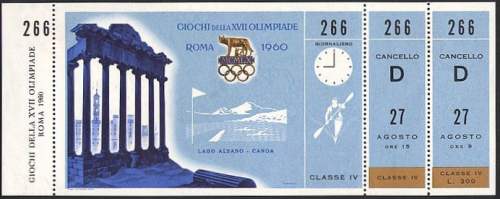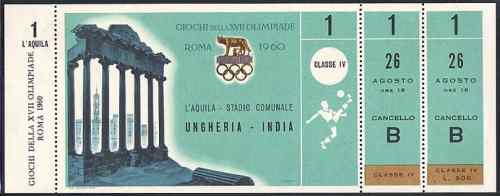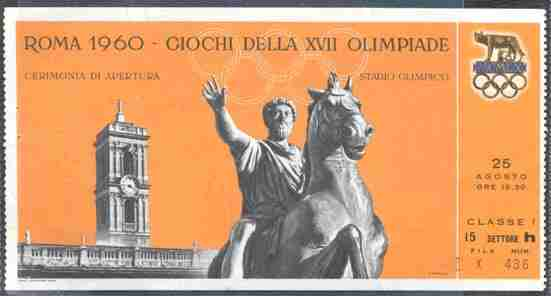Tickets
The Tickets 1960 The Section presented its estimates and the plans it had drawn up to a Committee of Experts composed of Messrs. Rastelli, Baglini, Marchesi, Righetti and Delia Vida. In view of the fact that the printing of tickets
by an engraving process would have involved approximately one year's work,
whilst this time would be reduced to some 5-6 months by a lithographic
process and also in view of the possibilities of forgery of the tickets
since " no printing technique exists however complex that entirely eliminates
the possibility of perfect imitations ", the Committee decided to adopt
the least costly and most rapid process, namely, the lithographic process.
It also decided to choose as the best defence against forgery a special
filigrained paper easily recognizable by its touch and sound. In fact,
the paper was manufactured exclusively for the production of the tickets,
in sheets weighing about 80 grammes, in a 70 X 100 cm. format. 28 tickets
of a 9.5 X 24.5 cm. format were printed on each sheet.
On the reverse side the tickets were illustrated with two-colour artistic Roman motifs, by the painter Corrado Mancioli, while on the front side were engraved and printed indications. A competition was held to decide who was to supply the tickets, the most well-known firms specialized in this branch being invited to participate. After careful consideration of the estimates presented, the Committee, composed of Messrs. Giuseppe Botti, Carlo Delia Vida and Tommaso Folinea, decided to entrust the supply of tickets to the firm of " Salomone " of Rome, whose offer was more favourable in price. There were four types of tickets whose main
characteristics in general were the same but varying in design, namely:
The tickets varied in colour for each sport (17 different colours) and varied in design for each venue (18 venues). Each sport also had a distinguishing design. The tickets were marked with coloured stripes varying in accordance with the necessary differentiation of the individual classification of seats in each competition venue. All tickets were marked to indicate the progressive numbering system, the venue, the entrance, place, date, and hour of commencement of each event; in addition they bore the letters " M ", " P " or " S " to indicate " morning ", " afternoon " and " evening " and the price of the ticket. On the back, besides the progressive number
being repeated, a small plan of the competition venue with indication of
the various sectors was included, thus allowing the ticket holder to find
his place more easily, and the official stamp of the Italian Association
of Authors and Publishers.
The Firm of Salomone delivered the tickets in blocks consisting of 50 units each. Each block was marked outside with the progressive number, price and sport, thus facilitating the various dispatch operations when the time came. ( Source document: Official Report 1960, Vol. 1, page 499) |


